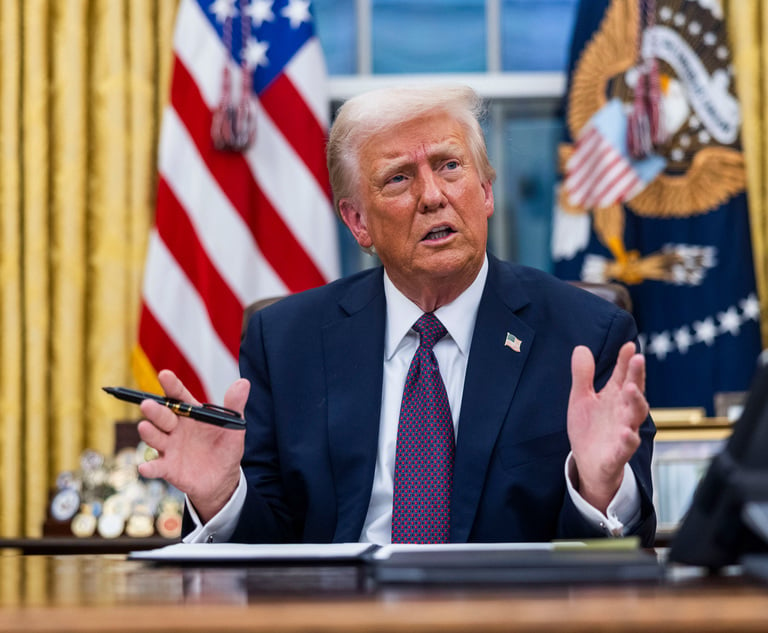Trump Administration Set to Impose Duties on Yarn From China, India
The volume of polyester-textured yarn coming into the U.S. from China and India has surged in recent years, growing from about 38 million pounds in 2013 to nearly 69 million pounds in 2017. That same year, imports of the yarn in question totaled $54.6 million.
May 02, 2019 at 02:44 PM
4 minute read
 U.S. Department of Commerce, Washington, D.C. (Photo: Diego M. Radzinschi/ALM)
U.S. Department of Commerce, Washington, D.C. (Photo: Diego M. Radzinschi/ALM)
In another example of the Trump administration's aggressive enforcement of U.S. trade law, the Department of Commerce is poised to begin collecting countervailing and antidumping duties on polyester-textured yarn imported from China and India.
The move comes after two major U.S.-based synthetic yarn producers alleged in petitions that China and India were harming the domestic industry by dumping cheap, subsidized imports of yarn on the U.S. market. In 2017, those imports from China and India totaled $35 million and $19.6 million, respectively, according to the Commerce Department.
“This is an important issue with respect to U.S. producers of fiber and textile products,” the petitioners' attorney, Paul Rosenthal of Kelley Drye & Warren in Washington, D.C., said in an interview Thursday. “We're happy that our allegations concerning subsidies by the Chinese and Indian governments have been found to be accurate and has resulted in some preliminary duties.”
His clients—Unifi Manufacturing Inc. in Greensboro, North Carolina, and Nan Ya Plastics Corp. America in Lake City, South Carolina—have asked the Commerce Department to impose antidumping and countervailing duties on the yarn in question. The agency on Monday announced affirmative preliminary determinations on the countervailing duties for foreign government subsidies and is expected to issue a preliminary determination on the antidumping duties in the near future.
The Commerce Department is slated to make a final determination on the duties later this year. In the meantime, U.S. companies that continue to import the yarn from China and India risk being hit with increased countervailing duty payments. At the moment, the Commerce Department has instructed the U.S. Customs and Border Protection to begin collecting cash deposits from U.S. importers of yarn from China and India based on preliminary subsidy rates that range from 20% to nearly 460%.
“These are provisional duties,” Rosenthal noted. “As this gets implemented, importers are being told the entries of their imports are not going to be liquidated. That means they will not be sent a final bill for these imports after publication in the federal register because [the government] is going to wait to see what final level of antidumping duties will be calculated. After that's done it sends a bill for the duties you have to pay.”
The American Apparel & Footwear Association, which represents more than 1,000 retailers and manufacturers in the industry, did not immediately respond to a request for comment on the yarn duties.
As part of its preliminary decision on the countervailing duties, the Commerce Department found that yarn producers and exporters in China and India were receiving significant government subsidies and inundating the U.S. market with underpriced yarn.
The volume of yarn coming into the U.S. from China and India has surged in recent years, growing from about 38 million pounds in 2013 to nearly 69 million pounds in 2017, according to the petition from Unifi and Nan Ya.
“The result has been that U.S. producers of the product have lost sales, and they've lost revenues because they haven't been able to meet the prices offered by China and India,” Rosenthal said.
Under Donald Trump's presidency, the Commerce Department has initiated 158 new antidumping and countervailing duty investigations—a 216% increase compared to the same period when Barack Obama was president. The Commerce Department also announced this week it has launched countervailing and antidumping duty investigations of ceramic tile imports from China.
“There have been more cases filed during the Trump administration, but it's not a Trump administration initiative,” Rosenthal said. “More cases are being filed, because I think people are encouraged that there will be strong enforcement.”
Read More:
EU Lists $20B in Proposed Tariffs on US Products Over Boeing Dispute
Strains on US-China Relations Continue to Cloud Asia Outlook in 2019
This content has been archived. It is available through our partners, LexisNexis® and Bloomberg Law.
To view this content, please continue to their sites.
Not a Lexis Subscriber?
Subscribe Now
Not a Bloomberg Law Subscriber?
Subscribe Now
NOT FOR REPRINT
© 2025 ALM Global, LLC, All Rights Reserved. Request academic re-use from www.copyright.com. All other uses, submit a request to [email protected]. For more information visit Asset & Logo Licensing.
You Might Like
View All
Netflix Music Guru Becomes First GC of Startup Helping Independent Artists Monetize Catalogs
2 minute read
Trending Stories
- 1Learning From Experience: The Best and Worst of Years Past
- 2Treasury GC Returns to Davis Polk to Co-Chair White-Collar Defense and Investigations Practice
- 3Decision of the Day: JFK to Paris Stowaway's Bail Revocation Explained
- 4Doug Emhoff, Husband of Former VP Harris, Lands at Willkie
- 5LexisNexis Announces Public Availability of Personalized AI Assistant Protégé
Who Got The Work
J. Brugh Lower of Gibbons has entered an appearance for industrial equipment supplier Devco Corporation in a pending trademark infringement lawsuit. The suit, accusing the defendant of selling knock-off Graco products, was filed Dec. 18 in New Jersey District Court by Rivkin Radler on behalf of Graco Inc. and Graco Minnesota. The case, assigned to U.S. District Judge Zahid N. Quraishi, is 3:24-cv-11294, Graco Inc. et al v. Devco Corporation.
Who Got The Work
Rebecca Maller-Stein and Kent A. Yalowitz of Arnold & Porter Kaye Scholer have entered their appearances for Hanaco Venture Capital and its executives, Lior Prosor and David Frankel, in a pending securities lawsuit. The action, filed on Dec. 24 in New York Southern District Court by Zell, Aron & Co. on behalf of Goldeneye Advisors, accuses the defendants of negligently and fraudulently managing the plaintiff's $1 million investment. The case, assigned to U.S. District Judge Vernon S. Broderick, is 1:24-cv-09918, Goldeneye Advisors, LLC v. Hanaco Venture Capital, Ltd. et al.
Who Got The Work
Attorneys from A&O Shearman has stepped in as defense counsel for Toronto-Dominion Bank and other defendants in a pending securities class action. The suit, filed Dec. 11 in New York Southern District Court by Bleichmar Fonti & Auld, accuses the defendants of concealing the bank's 'pervasive' deficiencies in regards to its compliance with the Bank Secrecy Act and the quality of its anti-money laundering controls. The case, assigned to U.S. District Judge Arun Subramanian, is 1:24-cv-09445, Gonzalez v. The Toronto-Dominion Bank et al.
Who Got The Work
Crown Castle International, a Pennsylvania company providing shared communications infrastructure, has turned to Luke D. Wolf of Gordon Rees Scully Mansukhani to fend off a pending breach-of-contract lawsuit. The court action, filed Nov. 25 in Michigan Eastern District Court by Hooper Hathaway PC on behalf of The Town Residences LLC, accuses Crown Castle of failing to transfer approximately $30,000 in utility payments from T-Mobile in breach of a roof-top lease and assignment agreement. The case, assigned to U.S. District Judge Susan K. Declercq, is 2:24-cv-13131, The Town Residences LLC v. T-Mobile US, Inc. et al.
Who Got The Work
Wilfred P. Coronato and Daniel M. Schwartz of McCarter & English have stepped in as defense counsel to Electrolux Home Products Inc. in a pending product liability lawsuit. The court action, filed Nov. 26 in New York Eastern District Court by Poulos Lopiccolo PC and Nagel Rice LLP on behalf of David Stern, alleges that the defendant's refrigerators’ drawers and shelving repeatedly break and fall apart within months after purchase. The case, assigned to U.S. District Judge Joan M. Azrack, is 2:24-cv-08204, Stern v. Electrolux Home Products, Inc.
Featured Firms
Law Offices of Gary Martin Hays & Associates, P.C.
(470) 294-1674
Law Offices of Mark E. Salomone
(857) 444-6468
Smith & Hassler
(713) 739-1250








